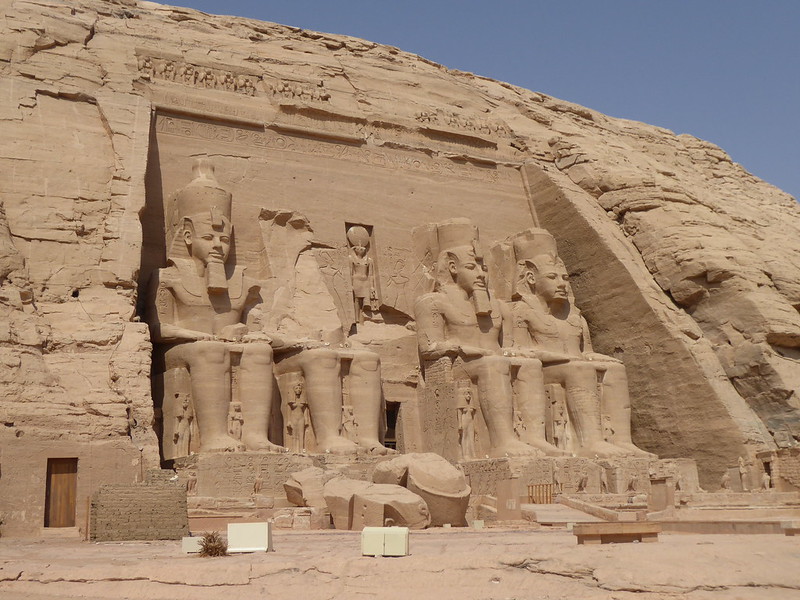
Deep within the Temples of Egypt sands of southern Egypt lies Abu Simbel, a testament to the power and grandeur of the Egyptian rulers. Constructed by Pharaoh Ramses II during the 13th century BC, these colossal temples are incredibly magnificent, carved directly into the cliffs and adorned with intricate sculptures and hieroglyphics. The temple complex consists of two main structures: a larger temple dedicated to Ramses II and a smaller one honoring his beloved queen, Nefertari.
The sheer scale of Abu Simbel is impressive.
Soaring over visitors are the four colossal statues of Ramses II, each measuring at over 65 feet high, their faces etched with wisdom. The interiors of the temples house a wealth of ancient art, including depictions of battles and scenes from Ramses II's reign.
The preservation and relocation of Abu Simbel in the 1960s, due to the construction of the Aswan High Dam, is a extraordinary feat of engineering and a testament to the importance of protecting ancient heritage. Today, Abu Simbel stands as a symbol of Egypt's rich history and a wonder for travelers from around the world.
A visit to Abu Simbel is an unforgettable experience that provides you to step back in time and contemplate the genius of the ancient Egyptians.
Exploring the Secrets of Abu Simbel, Egypt's Architectural Gem
Deep in the southern of Egypt lies Abu Simbel, a testament to the power and grandeur of ancient Pharaohs. This monumental complex, carved into the granite cliffs, is a masterpiece of engineering and artistry.
The two colossal temples, dedicated to King Ramses II, stand as towering guardians, their detailed facades adorned with sacred scenes and colossal statues. Inside, the spacious chambers are filled with murals that depict battles, while the golden light streaming through the carefully aligned openings casts dramatic shadows, illuminating the secrets of this ancient world.
A visit to Abu Simbel is a journey back in time, a chance to witness the ingenuity and artistic brilliance of one of history's greatest civilizations.
Luxor's Majestic Temple: A Legacy of Pharaohs
Rising from the sands of time, Luxor Temple stands as a epitome to the ancient Egyptians' architectural prowess and spiritual devotion. Its grandiose columns, intricately carved with scenes of deities and pharaohs, telling tales of a glorious past. The temple complex, once dedicated to the sun god Amun-Ra, features an array of awe-inspiring structures, including the famed Hypostyle Hall, where scores of massive pillars create a shadowy ambiance.
Throughout its vast grounds, visitors can explore the footsteps of pharaohs who honored Amun-Ra here, inscribing their legacy in the very stones. Luxor Temple is more than just a collection of ancient ruins; it is a vibrant memory of a civilization that prospered.
Hidden in the heart amidst Nubian lands, stands Simbel, Egypt.
A testament to grandeur power and architectural masterpiece, this extraordinary complex enchants us straight back to the reign under Pharaoh Ramses II. Twinned temples, carved majestically into sheer rock faces, rise as a monumental symbol to the pharaoh's dominance. Visitors are invited to marvel the intricate designs that narrate scenes about Ramses II's life and conquests.
The temples contain a wealth of historical and artistic gems, offering a glimpse into the wealth of ancient Egypt. The monumental scale coupled with the detailed carvings make Simbel an majestic experience, a destination that truly transports you to another time period.
Journey Through Time at the Temples of Nubia
Venture into the ancient realm of Nubia and discover the magnificent temples that whisper tales of a bygone era. These awe-inspiring structures, constructed from sturdy sandstone, stand as testaments to the masterful skills of their creators. Through weathered walls and decipherable carvings, we can piece together the rich history and vibrant culture of this forgotten civilization. Each temple offers a unique glimpse into the beliefs and practices of the Nubian people, their reverence for their gods, and their mastery over the art of temple erection.
Amble through the ruins, where centuries-old stones narrate stories of a glorious past. Feel the weight of history as you gaze upon the majestic obelisks and intricate reliefs that adorn these sacred spaces. Let your imagination fly as you walk through time, surrounded by the echoes of ancient rituals and ceremonies.
Exploring the Mysterious Power of Abu Simbel
Abu Simbel stands as a monumental testament to the power and grandeur of ancient Egypt's Pharaoh Ramses II. Carved from sheer rock face, these imposing temples are not merely architectural achievements, but also powerful symbols of a civilization that thrived for centuries.
The temple's orientation with the sun on specific days of the year creates an magical spectacle, casting light deep within the sanctuaries and illuminating the giant statues of Ramses II. This celestial precision speaks to the Egyptians' profound understanding of the universe and their ability to utilize its power.
Visiting Abu Simbel is a transformative experience that immerse you in the essence of ancient Egypt. It's a reminder of the enduring legacy of this empire, and its ability to captivate us even millennia later.